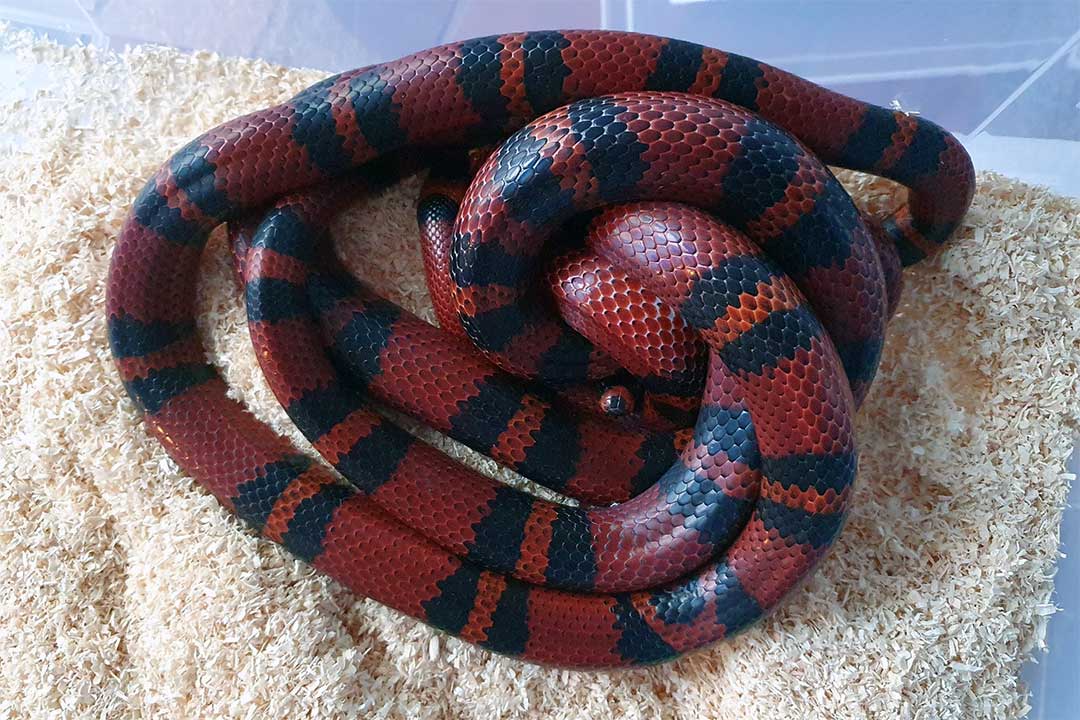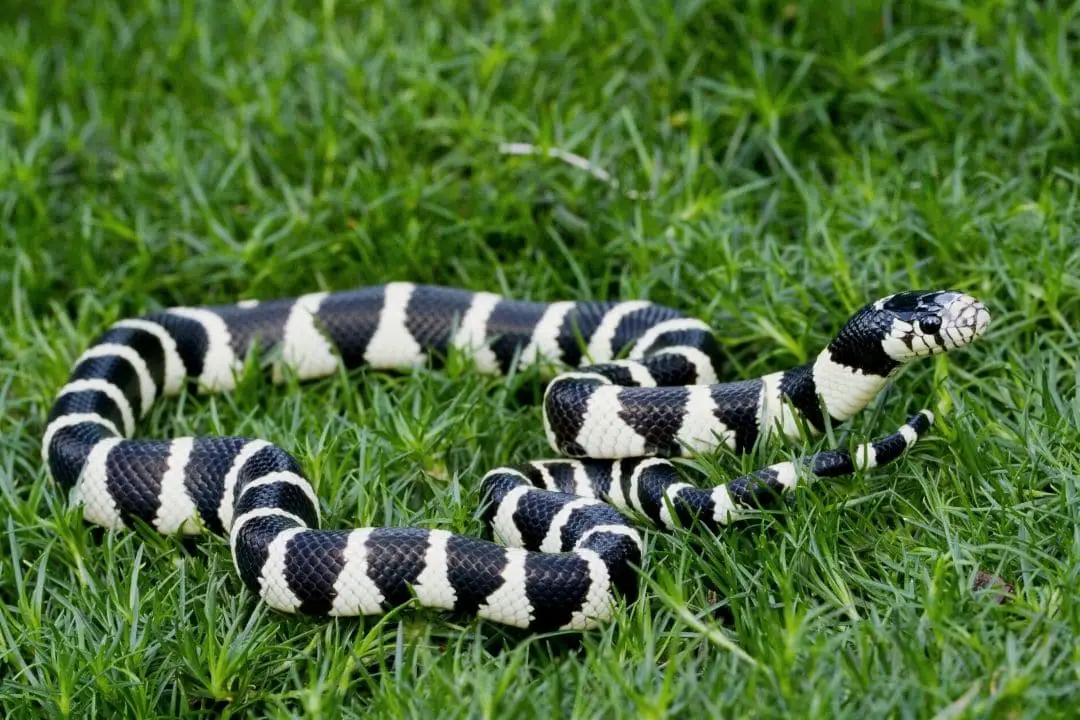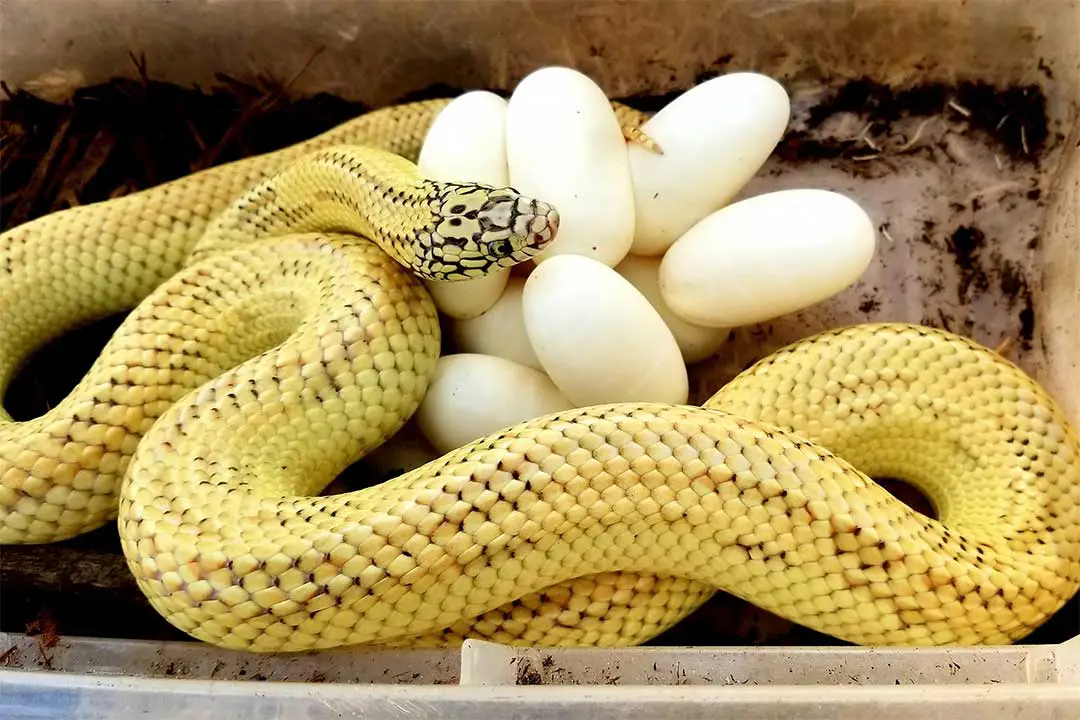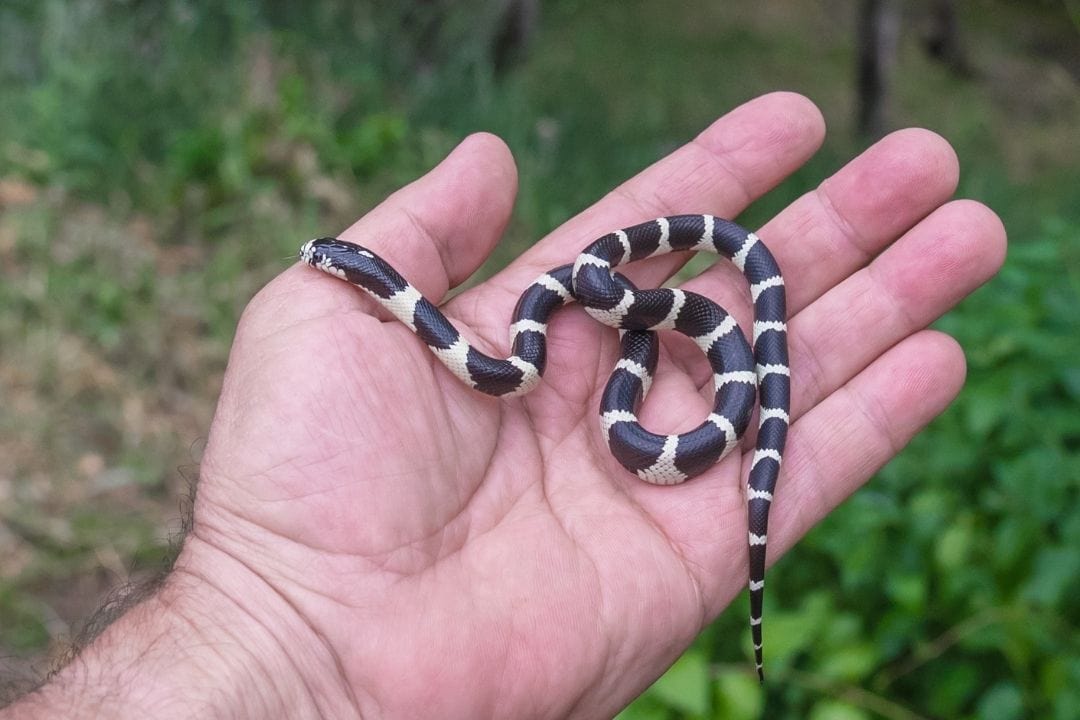Breeding any animal is a big step. You need to provide proper care for both the parents and babies to ensure healthy animals.
This guide will teach you how to breed king snakes.
It is best to start in late summer for your region. This is because you will need to induce brumation and this is done most easily during the winter.
Step 1: Requirements
Your first step is to ensure you have at least 1 male and 1 female king snake of the same species. You can have them sexed by a reptile vet or experienced reptile keeper.
Many breeders will check their new hatchlings, so you might already know for sure what you have. You also need to make sure they are fully grown adults.
Breeding too early can injure your snakes. You will want to have a goal in mind. Decide on what you want your goal to be, whether trying to create a new morph or refine an existing one.
Another thing to note is that some snakes just aren’t fertile. It could be that the snake is too young, but some animals are just infertile. Having at least 2 male snakes and 4 females can help make sure you have fertile animals.
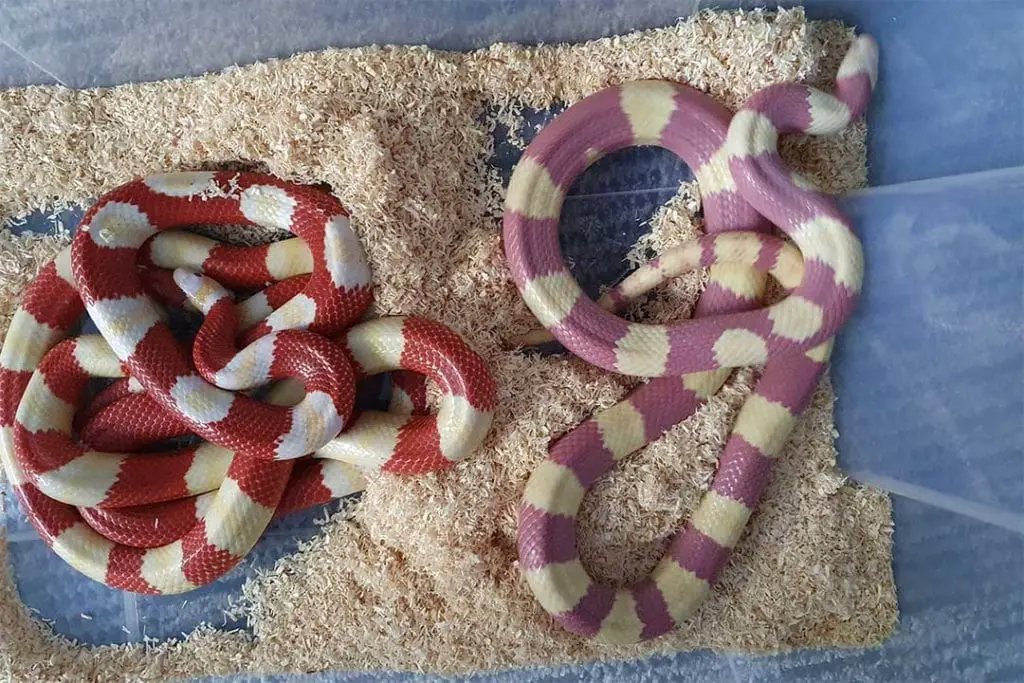
You should also make sure you know the genes you have and how in-demand they are. Some colors and genes are more in demand than others. You will also want to make sure you have potential homes lined up for any babies. Kingsnakes lay between 6 and 20 eggs, but most clutches are on the smaller side. If half of the eggs are fertile, then you are looking at 3-10 baby snakes you need to feed and house until you find new homes for them.
A note on inbreeding, for the most part, breeding related snakes doesn’t seem to have too many obvious effects. The main issue seems to be lower fertility rates.
For your own stock, you may want to try to get unrelated snakes, depending on what your breeding goals are.
Step 2: Timing
Once you have this, you need to time things properly. During late summer, starting around August in the northern hemisphere, you need to feed both the male and female as much as they will accept.
Keep your temperatures around 85 on the warm side and offer as much food as they will take. Females need extra energy to form eggs, and males will frequently refuse food during the mating season.
This is your chance to make sure he will be healthy afterward. Try to feed at least once a week and see if your snake will take multiple prey items.
You want the snakes to develop some extra body fat, but not be obese.
Step 3: Preparing for Brumation
Once winter temperatures in your area begin, you can prepare your snakes for brumation. In late November or early December, you need to stop feeding your snakes.
Give the snakes at least 2 weeks at the normal temperature with no food.
This gives them time to digest. If anything remains undigested, it will rot once the temperature drops and can kill your snake. Your snake will likely want less food during this time anyway.
Make sure you check that your snakes are healthy enough before you commit to breeding them.
Step 4: Brumation
Once your snakes have fully digested, it is time to slowly lower the temperatures. Over a week, lower the temperature of your snakes from room temperature to about 50-65 degrees.
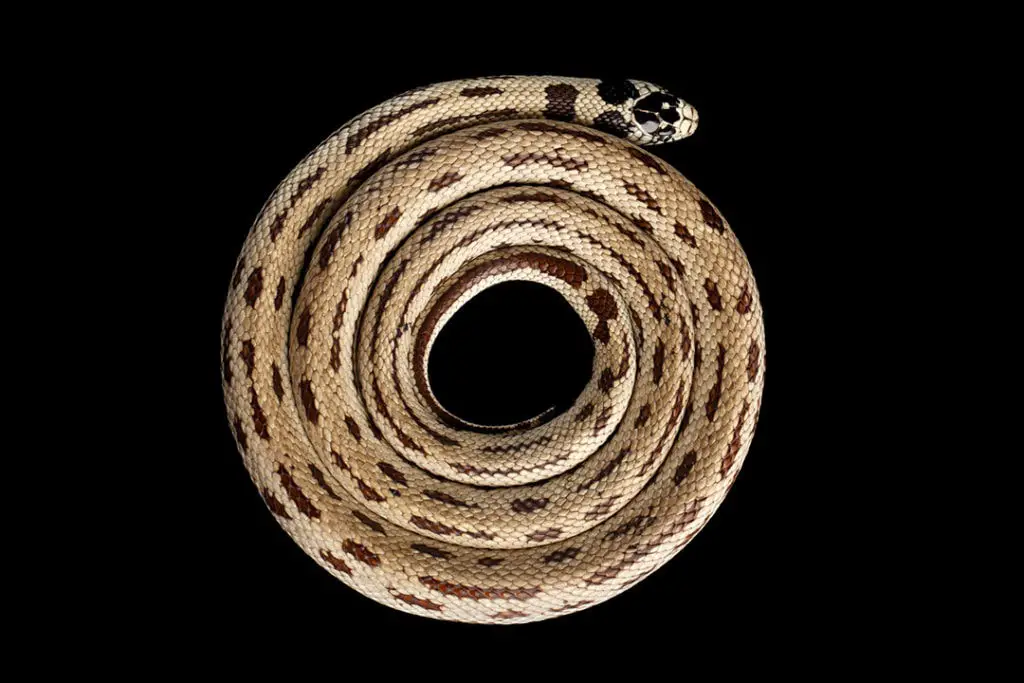
If you have the right ambient temperatures in the room your snakes are in, they can stay in their normal enclosures. If you don’t have a dedicated room for your snakes or you can’t keep the room at the right temperature, a small refrigerator or wine cooler can work. You will need to place your snake in a new container with air holes and a water dish.
Make sure there are air holes. and let your snakes slowly cool down. If you can’t keep your temperatures at the right level, you can crack the door or get a thermostat.
A small wine cooler like this one works well if you have just a few snakes since you can set the exact temperature. They need to stay in this state for 2-3 months.
Step 5: Ending Brumation
After 2-3 months, it is time to wake up your snakes. This needs to be done slowly, or you could harm them. Raise them to room temperature over a week.
This means either letting the room they are in warm up or leaving the door to the cooler open for longer periods.
If you are using something controlled with a thermostat, just raise the temperature by a degree every few hours for a week until you hit around 72.
Once your snakes are at room temperature, you can turn on their normal heating and let them warm up fully.
Step 6: Preparing to Breed
Once your snakes are active, start offering food. Males may refuse food, but females need as much as you can offer. Keep an eye out for the female’s first shed.
Female snakes shed right before they are ready to start breeding. If the shed is very soon after you start feeding, however, she may need more time.
This is so her egg follicles can develop. If you handle a calm snake and feel along her belly, you may be able to feel lumps like soft marbles in the back half of her body. These are the eggs that will develop if fertilized.
Step 7: The Breeding
Now is the time to introduce the male to the female snake’s enclosure. Since kingsnakes will eat other snakes, you need to watch and make sure they are actually willing to breed rather than kill each other.
If the snakes are interested in mating, you will notice the male pursuing the female.
He will attempt to restrain her by pinning her down or even biting. Then he will try to align his anal plate with hers. If the female isn’t receptive, she will thrash her tail and attempt escape.
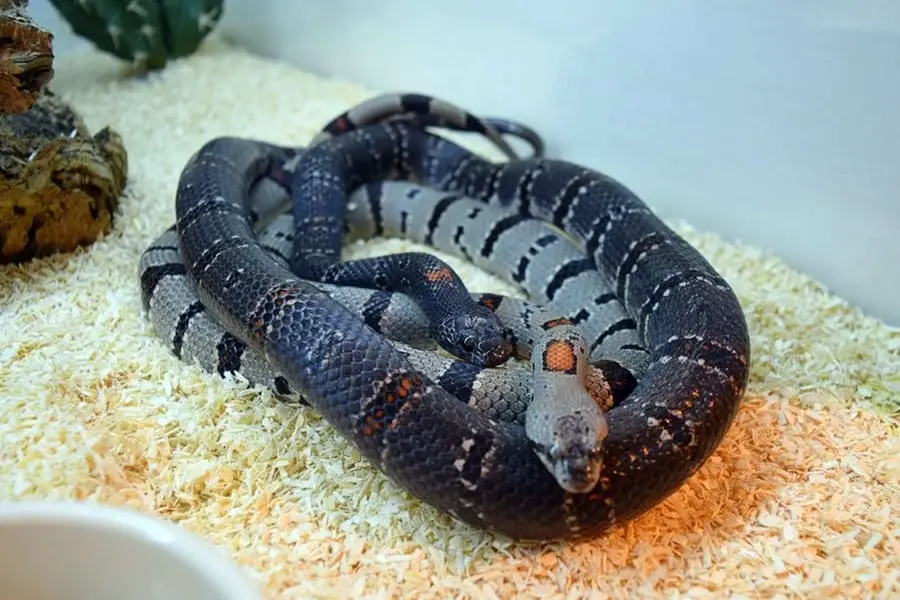
If you see this, separate them immediately. Wait a few days before trying again. If she is receptive, they will mate. Mating kingsnakes can be locked together for 5 minutes, or it may take hours.
You should check on them regularly until they are separated. Once they are, be sure to remove the male back to his own enclosure.
You can allow them to mate again the next day if you want to increase fertility, but it isn’t needed. One male can fertilize several females, but be sure to give him a day or two between mating to allow him to rest.
Step 8: Caring for Gravid Females
Once you have bred your snakes, you can resume normal care for the male. The female will need some special care if she is gravid.
Gravid means that she is carrying developing eggs. You will notice her sides begin to swell as the eggs develop. She needs to be kept warm and offer as much food as she will take.
Some females will refuse food as soon as she is gravid. If you notice this, try to offer smaller prey. Some reluctant females may take a prey item that is 1/3 the size of a normal mouse.
About a month after she becomes gravid, she should shed her skin. After this, she will start searching for a place to lay her eggs.
Step 9: Preparing a Laying Box
In the wild, kingsnakes will select a warm, damp place to lay their eggs. Female kingsnakes will leave the eggs to allow them to hatch. You will need to create a good place for her to lay her eggs.
A box with a hole cut in the side makes a good lay box. It needs to be closed, ideally dark, and hold some damp sphagnum moss.
Terrarium Sphagnum Moss
- Long-Lasting: Long-Fiber and Leafy Green Sphagnum Moss
- High Absorbency: Controls Tropical & Wetland Humidity
- Sustainable: Ecologically Regulated Harvests

You can use a plastic container or a cardboard box with a hole cut in the side. Just make sure the whole snake can fit so she will want to use the box.
You should add the lay box as early as you can since some female kingsnakes can lay as soon as 25 days after mating. Once you have it in, check it daily to make sure the moss is kept moist and to see if she has laid her eggs.
Step 10: Laying
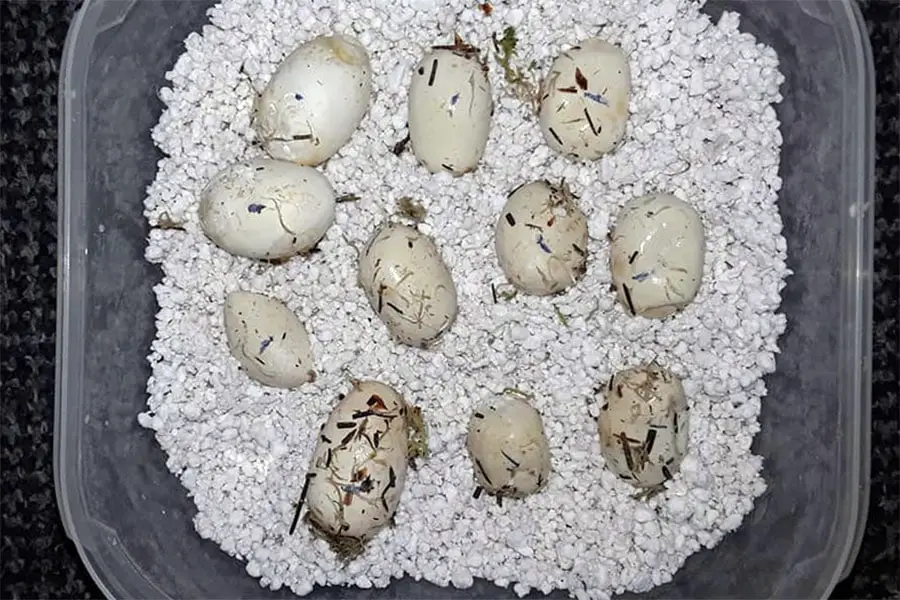
About 10-14 days after the pre-laying shed, the female will lay her eggs in the laying box you provided. Some female snakes will try to lay in the water dish.
You may want to remove the water dish for most of the day so she doesn’t lay in the water and kill the eggs. Once you see eggs in the lay box, check the female to make sure she has laid them all. You can feel the eggs or even see them as lumps close to her cloaca.
Once all the eggs are laid, remove them promptly. Female kingsnakes have been known to eat their eggs. If your snake is having trouble laying all her eggs, she may need to go to the vet.
It typically takes about 24 hours for a kingsnake to finish laying. If it takes longer, this may be a case of retained eggs. Retained eggs can hurt your snake. If you are concerned, call your reptile vet and ask for advice.
Please note, some people will try to produce a second clutch of eggs. If you can convince your female to eat and she is in decent condition, you have the option.
She may ovulate again after eating a few meals. Just note that this can be dangerous for the snake if she isn’t healthy enough.
Step 11: Preparing the Eggs
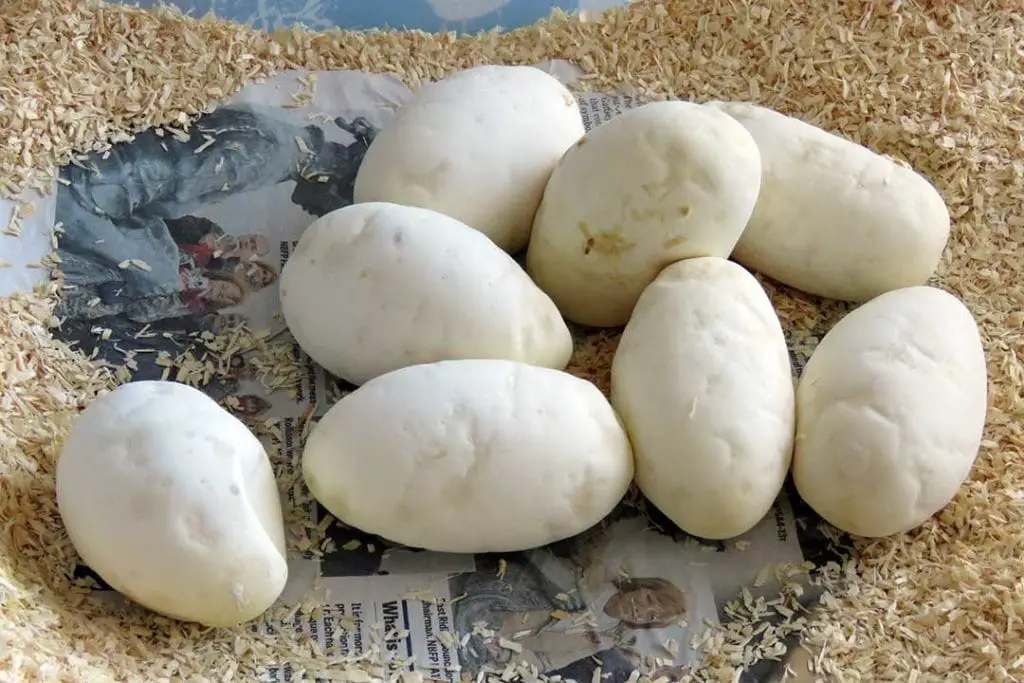
Once you have your eggs, it is time to prepare to incubate them. You need a plastic box with a lid that is at least 4 inches tall. Drill a few holes in the lid for ventilation, and then fill it 3/4 of the way up with sphagnum moss, perlite,vermiculite, or peat moss that you keep damp.
The goal is for the container to remain at 100% humidity with some airflow. Snake eggs will typically stick together after they are laid. If you catch them quickly, it is possible to gently separate them.
However, it is possible to rip the leathery shells and kill the embryos. If you are worried, just use a container that is large enough to fit the whole clutch.
Make sure you don’t rotate the eggs when placing them in the container. If you turn them over, it can make the embryo detach from the shell wall and die.
Step 12: Incubating the Eggs
Once the eggs are in the container with the lid on, it is time to work on incubation.
At 80-82 degrees, the eggs will take about 60 days to hatch. It takes longer at lower temperatures.
At the mid-70s temperature range, it will take over 90 days.
You never want your eggs to reach over 85 degrees.
This will kill them. High temperatures are much more likely to kill the eggs than cold temperatures will. You can incubate anywhere the temperature stays stable enough.
Some people incubate in the reptile room or a room with the right ambient temperatures. You could also make your own incubator with a thermostat and heat tape.
Reptile Eggs 25L Incubator
- Temperature can be adjusted from 36 to 140°F), providing a constant temperature incubation environment.
- Having a roomy 25L chamber volume and with a built-in handle, the incubator is easy to move around.

I recommend the reptile incubator above if you prefer something very reliable and that you don’t need to make yourself.
Most incubators on the market are meant for chickens or other birds. Bird eggs need to be turned, but turning will kill a developing snake.
Step 13: Checking for Fertility
Infertile eggs are possible, so you should keep an eye out. If you want to check, wait a week and candle them.
This means holding the egg against a bright light in a dark room and looking to see if the egg has any signs of development like veins or an embryo.
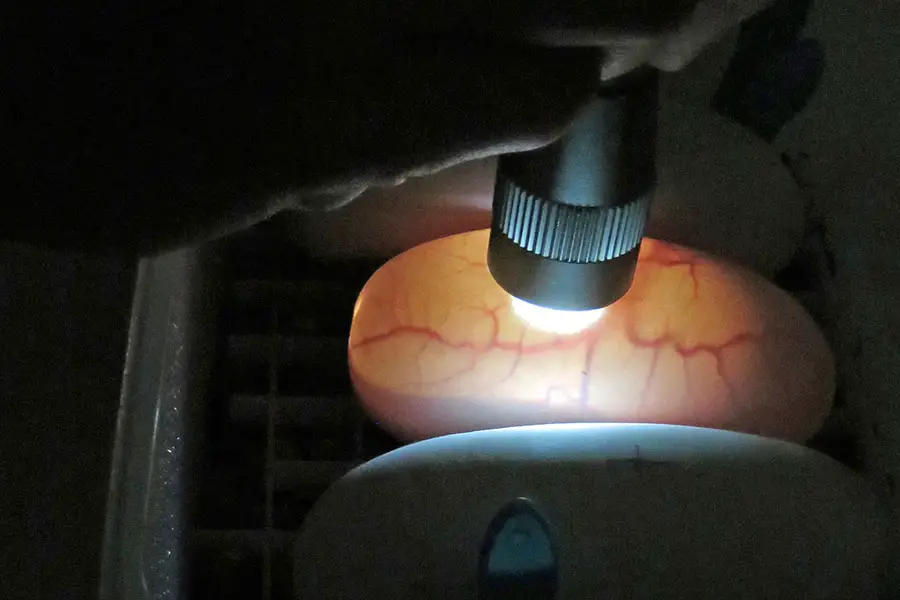
If you aren’t sure, keep the egg. Infertile eggs will mold over, though some fertile eggs will mold as well. This can be fixed by brushing it off with a soft toothbrush. You will notice a foul smell from bad eggs.
They can be thrown away if they can be separated. If not, you can cut open a bad egg and rinse it out without harming any attached healthy eggs.
Snake eggs can take a brief rinse with warm water.
Step 14: Monitoring the Eggs
Once your eggs are in, you need to make sure they stay damp and have air circulation. Snake embryos need to breathe through the shells, so you need some air.
A healthy egg will be full, firm, and white or cream. If you see dents in the shell, you need to increase the water.
Make sure the incubation substrate stays damp.
You should see condensation on the inside of the incubation container. It is possible for an egg to split if it absorbs too much moisture.
Try to err on the side of too dry since it is easier to rescue a too dry egg.
Step 15: Hatching the Eggs
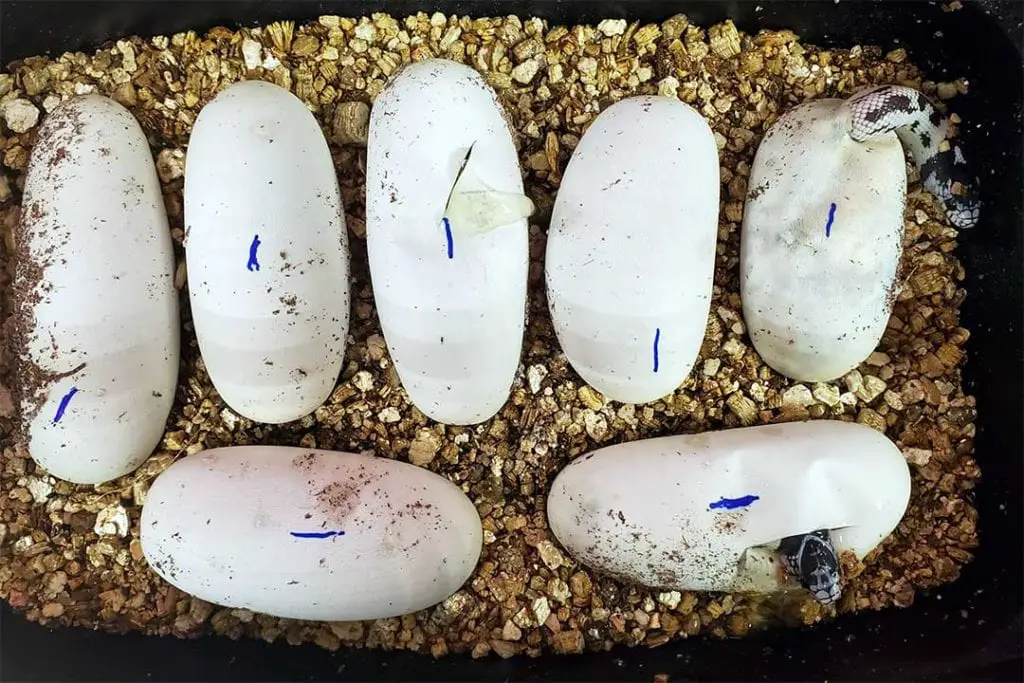
Hatch times depend on temperature. At around 80, it should take about 60 days. A week before the eggs hatch, you will notice them seem to deflate.
This is normal, and not a sign you need to add more water. You will see the baby snakes slit holes in the shell with an egg tooth on the tip of the snout.
Once the slits are made, the babies will typically stay in the shell to rest and finish absorbing the yolk of the egg. You should leave the babies alone until it exits the egg on its own.
Check to see if any hatchlings are outside of the eggs regularly and remove them to a separate container as soon as you can. Baby kingsnakes will eat each other if left alone, so keep an eye on them.
If you notice an egg isn’t slitted on its own even after all the other eggs have hatched, you can slit it yourself to check on the baby. If the baby snake moves when you poke it, just let it come out on its own.
Step 16: Caring for Hatchlings
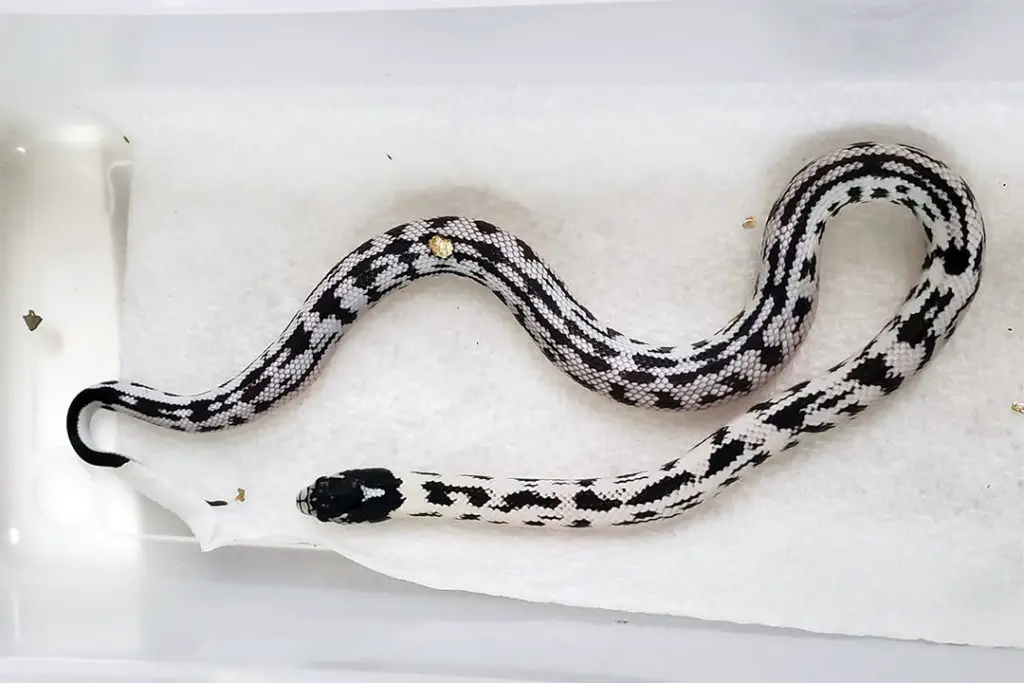
Hatchlings should be placed into a small enclosure to start off. Many breeders use plastic shoeboxes with holes drilled in for ventilation for hatchlings.
Make sure you tape the lid so the snake can’t force it open. The substrate for a hatchling can be a paper towel, and you should provide a hide and water.
Many newly hatched snakes won’t eat for a week, or until they shed for the first time but some can take longer. You should offer pinky mice to induce feeding.
Some snakes will prefer a dead pinky over a live one.
They may also prefer something like lizards or frogs. You can use a lizard or frog to scent a pinky and induce the snake to take it.
Shed skin from a lizard may also help. You may need to feed something else and move the snake onto mice later. Force-feeding is an option, but it carries the risk of killing the snake.
Conclusion
Now that you know how to breed king snakes, you just need to try it for yourself.
There are many beautiful morphs out there to breed. Just remember to care for your snakes well and they should stay healthy. Comment below on your own experiences, and share what snakes you have bred!
Everything you need to know about caring for King Snakes in captivity:
Read our California King Snake Care Sheet (Complete Guide)
